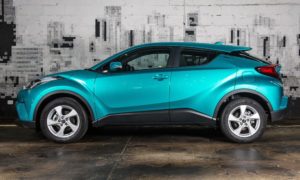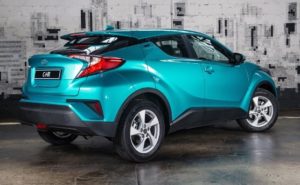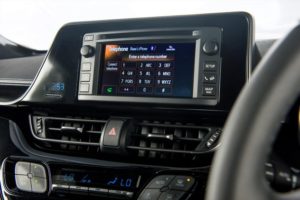
Thabiso Malimela Reviews. 09/06/2017
In April, Toyota left everyone with their jaws one the ground as they unleashed their rude-looking monstrosity – the C-HR. What this car is is Toyota’s answer to the compact crossover segment which sees it go against already established and fellow Japanese competitors such as the good looking CX-3 from Mazda and Nissan’s Qashqai. Fast forward one month from initial release, you’ll see that the sales reports for the month of May tell us that Toyota managed to shift 189 units of the C-HR. I suspect that this figure is an understatement considering the supply issue from the C-HR’s assembly plant in Turkey. Despite the already high demand for this vehicle locally and globally, Toyota can only manage to bring 150 units to our shores each month which really is a shame really (I hope I don’t have to explain why).
Toyota’s C-HR has its scope set on the young “trailblazers” of the world, those who seek individuality and want to stand out from the crowd, and assumingly, those who are unapologetic about who they are and how they go about doing things. Did I also mention young? (Sorry Gogo, this one’s not for you). This clear customer profile creates a rather singular design brief, which the C-HR meets with a lot of controversy to spare. The first of which is what inspired Toyota to move away from their usual play-it-safe strategy of producing cars that look like they were designed in a rush on a Friday afternoon and the second being what does this mean for the designs of Toyota’s future cars. Seeing as we can only wait and see what happens to Toyota in the future, for now, let’s instead chew on this Japanese red hot chilli. Bring on the milk, this thing is hot!
Exterior



Let’s start with what brought you here in the first place – the exterior (which I’m sure was clickbait). Toyota looked at its target buyer and thought to themselves that they need to design a car for a stylish, individualistic person whose decisions are inspired by emotions. The C-HR looks to be an extension of its buyer’s personality because it too is stylish, individualistic and its design inspires an emotional response to the one who lays their eyes upon it. Looking at it from the side, you notice how the roofline contour resembles that of a coupe thus giving it a very sporty look. And like a coupe, it looks like it has only two doors because the rear door handles are “hidden” in the C-pillar which also integrates the rear window with the rear door glass – very sexy indeed. There is a line that outlines the wheel arches and continues from the front headlights through to the rear taillights. The front is a relatively tame when compared to the side and rear. From the front, the car looks narrow. It could have something to do with those headlights which look like they’re trying to reach out and touch one another. But you quickly forget that when you see the front bumper and grille design which give the car a “fusek” facial expression. The rear continues the sharp and edged design them with arrow looking taillights and some interesting lines around the number plate area.
Interior
 Toyota have cut the C-HR pie into three pieces. You get a base spec model, a Plus trim and a Plus spec with a CVT gearbox. For the sake of the interior, let’s just say two pieces, base and Plus. The C-HR comes standard with bi-halogen headlights with LED daytime running lights, electric windows and mirrors, a multifunctional steering (that’s with the buttons and stuff), cloth seats (upgradeable to leather as an aftermarket option) and a touchscreen infotainment system with 6 speakers. Choosing the Plus trim will get you a leather steering wheel (still multifunctional), a colour multi-information display between the engine and speed dials, cruise control, automatic dual-zone air conditioning, automatic lights and wipers and front and rear fog lamps. All is well up until you step into the rear seats. Getting in is an easy task, but staying in there would arise some anxiety. Rear legroom is not the best but don’t worry, it’s a huge improvement from the backseat of a minibus taxi. Remember that C-pillar we just spoke about? Well because of its generous size, the headroom will leave you feeling considerably claustrophobic if you’re taller than the average Joe. The sloping roofline and vast C-pillar mean that the C-HR has a set of blindspots that only a supercar owner will appreciate. Although not exactly in the league of Lexus, there is a certain satisfactory premium feel to the C-HR’s interior despite the lack of premium materials such as leather and some metals (you thought I was going to say wood weren’t you?).
Toyota have cut the C-HR pie into three pieces. You get a base spec model, a Plus trim and a Plus spec with a CVT gearbox. For the sake of the interior, let’s just say two pieces, base and Plus. The C-HR comes standard with bi-halogen headlights with LED daytime running lights, electric windows and mirrors, a multifunctional steering (that’s with the buttons and stuff), cloth seats (upgradeable to leather as an aftermarket option) and a touchscreen infotainment system with 6 speakers. Choosing the Plus trim will get you a leather steering wheel (still multifunctional), a colour multi-information display between the engine and speed dials, cruise control, automatic dual-zone air conditioning, automatic lights and wipers and front and rear fog lamps. All is well up until you step into the rear seats. Getting in is an easy task, but staying in there would arise some anxiety. Rear legroom is not the best but don’t worry, it’s a huge improvement from the backseat of a minibus taxi. Remember that C-pillar we just spoke about? Well because of its generous size, the headroom will leave you feeling considerably claustrophobic if you’re taller than the average Joe. The sloping roofline and vast C-pillar mean that the C-HR has a set of blindspots that only a supercar owner will appreciate. Although not exactly in the league of Lexus, there is a certain satisfactory premium feel to the C-HR’s interior despite the lack of premium materials such as leather and some metals (you thought I was going to say wood weren’t you?).

Engines
The C-HR is only available only with one engine – a 1.2 litre 4 cylinder 16-valve turbo-petrol dubbed 8NR-FTS (whatever that means) producing 85kW and 185Nm of torque through the front wheels. With a kerb weight of 1425kg at the heaviest spec, don’t expect to win any drag races unless you’re competitor can’t match your 0 to 100km/h time of 10.9 seconds. You can keep going until the car stops accelerating at 190km/h (185km/h on the CVT), but I wouldn’t bother if I were you because this car is most comfortable at cruising speeds. You can mate your powerplant to one of two transmissions. Fans of the three pedal setup will be pleased to know that the C-HR is available with a 6 speed manual gearbox with iMT which automatically blips the throttle when you go down a gear so as to rev match and give a smooth downshift. Sorry to all the heel and toe purists, not everybody is as adept as you! For those of you who spend a substantial amount of time in bumper-to-bumper traffic, worry not because Toyota offers the C-HR with a CVT (Continuously Variable Transmission) in Plus trim only. Reports suggest that Toyota’s CVT on the C-HR lacks the noisy winding and indecisiveness that has plagued all CVTs in the past. It flows through the virtual ratios smoothly and is inaudible until you get really high up in the revs. The C-HR gives you an option of choosing between three driving modes – Normal, Eco and Sport. I’m pretty sure these three driving modes make as much difference to the car as diet water on your waistline (diet water is no different to normal water). If you put it in Eco mode, you’ll be able to achieve a fuel consumption of 6.3 litres/100km on the manual and 6.4 on the CVT. Put it in the other driving modes and you’ll probably achieve the same figures anyway.
Safety
Toyota is not a byword for safety and with the C-HR only being equipped with two airbags (driver and front passenger), it will continue to be so. However, it does come with an electronic parking brake with hill holding function, vehicle stability control and ABS (Anti-lock Braking System) with EBD (Electronic Brakeforce Distribution). The steering is electric which means manoeuvring through traffic or fighting to fit the C-HR into parking spots will be less taxing.
Summary
Toyota says that the C-HR will appeal to young individuals but honestly, anyone who’s at least young at heart can buy this car. Knowing South African buyers, only a few will care about who the car was meant for and being the emotive buyers they are (mostly driven by looks), they’ll be fighting to own a C-HR. If you can overlook the hideous blindspots and awkward rear space, you’ll see that the C-HR is a really attractive package (see what I did there?) and will be tough to match. It has been out for a short time but already has had a lot of recognition after being nominated for the 2017 World Car of the Year and 2017 World Car Design of the Year (lost both to Jaguar F-Pace). Good luck getting one though because it seems that they sell out as soon as they arrive at dealerships each month. So be that early bird and go get yourself a C-HR (ask for one in red).|
 Pricing
Pricing
1.2 T – R318 500
1.2 T Plus Manual – R345 000
1.2 T Plus CVT – R356 000
Specs
Ground Clearance – 160mm
Turning Circle – 5.2m
Fuel Tank – 50L
Seats – 5
Luggage Capacity – 328L
Wheelbase – 2 640mm
CO2 Emission – 141g/km
Towing Capacity (braked) – 1 300kg
Towing Capacity (unbraked) – 720kg
Alternatives
- Mazda CX-3
- Nissan Qashqai
- Honda HR-V
- Hyundai Creta
- Renault Captur
- Opel Mokka
- Suzuki Vitara
Thabiso Malimela Reviews. 09/06/2017 #TheAutomobileGenius
